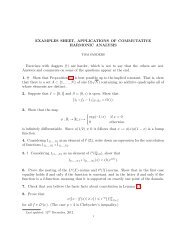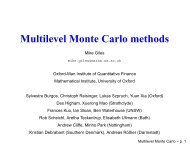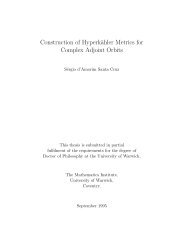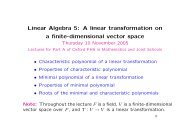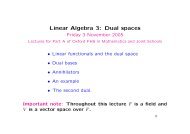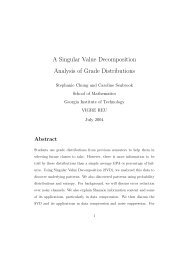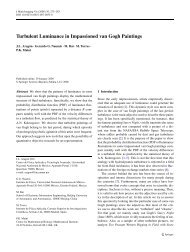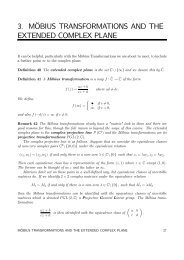Fourier Series and Partial Differential Equations Lecture Notes
Fourier Series and Partial Differential Equations Lecture Notes
Fourier Series and Partial Differential Equations Lecture Notes
You also want an ePaper? Increase the reach of your titles
YUMPU automatically turns print PDFs into web optimized ePapers that Google loves.
Chapter 4. The wave equation 35<br />
where l, <strong>and</strong> τ are a typical lengthscale <strong>and</strong> timescale, respectively, for the problem under<br />
consideration. Then<br />
<strong>and</strong> substituting into the wave equation we have<br />
∂ dt ∂ 1 ∂<br />
= = ,<br />
∂t dˆt ∂ˆt τ ∂ˆt<br />
∂<br />
(4.15)<br />
2 <br />
dt ∂ 1 ∂<br />
= =<br />
∂t2 dˆt ∂ˆt τ ∂ˆt<br />
1<br />
τ2 ∂2 ∂ˆt 2,<br />
(4.16)<br />
∂ dx ∂ 1 ∂<br />
= = ,<br />
∂x dˆx ∂ˆx l ∂ˆx<br />
∂<br />
(4.17)<br />
2 <br />
dx ∂ 1 ∂<br />
= =<br />
∂x2 dˆx ∂ˆx l ∂ˆx<br />
1<br />
l2 ∂2 ∂ˆx 2, (4.18)<br />
l<br />
τ2 ∂2ˆy ∂ˆt 2 = c2l l2 ∂2ˆy ∂ˆx 2.<br />
Rearranging gives<br />
∂ ˆ T<br />
∂ˆt = c2τ2 l2 ∂2ˆ T<br />
∂ˆx 2.<br />
Considering the problem on a timescale where τ = l/c gives<br />
Notice that now<br />
since<br />
∂ 2 ˆy<br />
∂ˆt 2 = ∂2 ˆy<br />
∂ˆx 2.<br />
(4.19)<br />
(4.20)<br />
(4.21)<br />
[ˆx] = 1, [ˆt] = 1, [y] = 1, (4.22)<br />
[l] = m, [τ] =<br />
<br />
l<br />
= s. (4.23)<br />
c<br />
This gives a relationship between problems with different lengthscales <strong>and</strong> wave speeds.<br />
4.3 Normal modes of vibration for a finite string<br />
A string is stretched between x = 0 <strong>and</strong> x = L <strong>and</strong> the ends are held fixed. If the string<br />
is plucked, what notes do we hear? The question suggests that we want a solution which<br />
is periodic in time, with a period to be determined.<br />
The displacement y(x,t) satisfies the wave equation<br />
with boundary conditions<br />
∂2y ∂t2 = c2∂2 y<br />
∂x2, (4.24)<br />
y(0,t) = 0 <strong>and</strong> y(L,t) = 0 for t > 0. (4.25)<br />
Weusetheseparationofvariablestechniquei.e. weattempttofindsome(notall)solutions<br />
of equations (4.24) <strong>and</strong> (4.25) in the separable form<br />
y(x,t) = F(x)G(t). (4.26)




